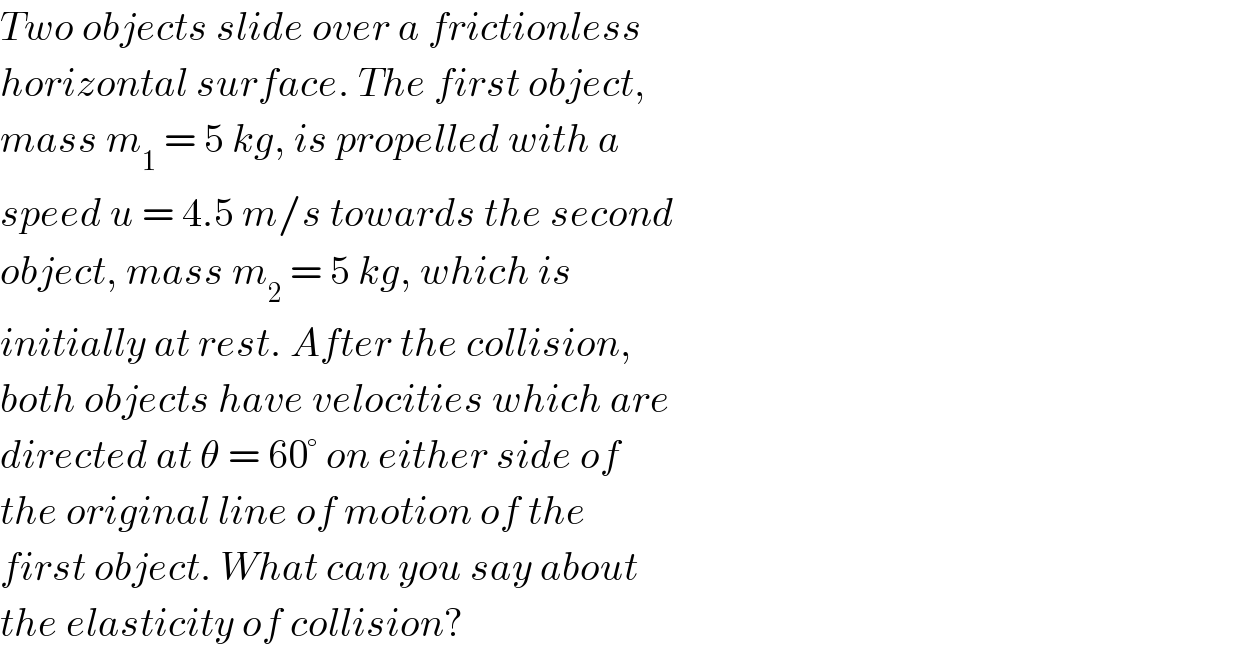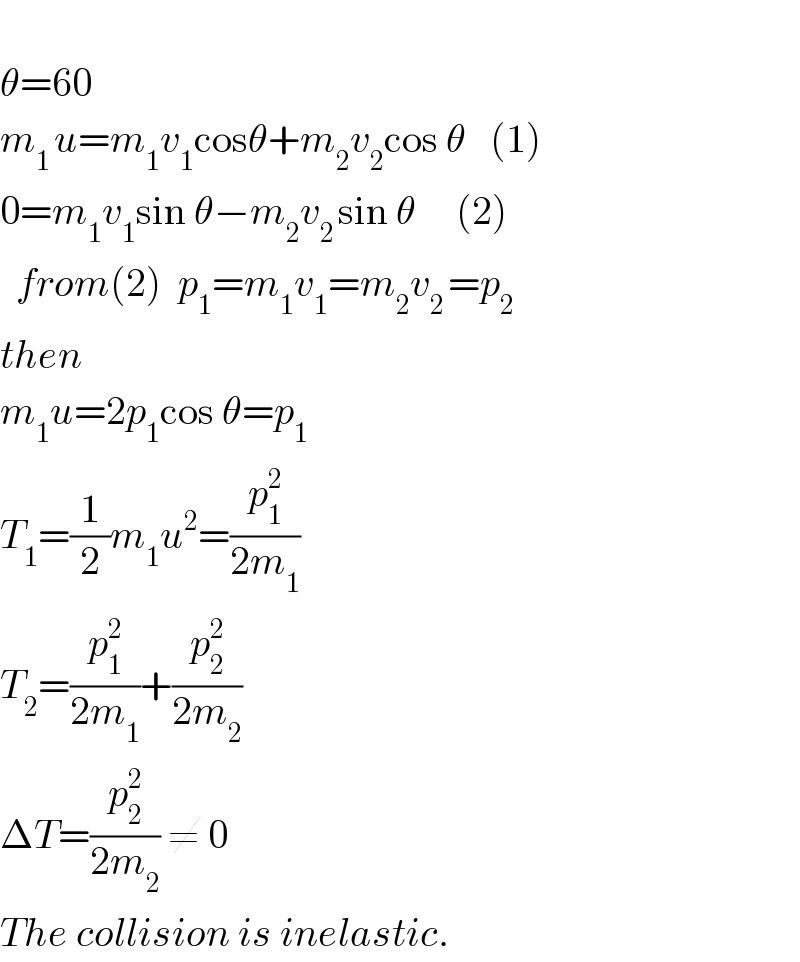Question Number 25058 by Tinkutara last updated on 02/Dec/17

$${Two}\:{objects}\:{slide}\:{over}\:{a}\:{frictionless} \\ $$$${horizontal}\:{surface}.\:{The}\:{first}\:{object}, \\ $$$${mass}\:{m}_{\mathrm{1}} \:=\:\mathrm{5}\:{kg},\:{is}\:{propelled}\:{with}\:{a} \\ $$$${speed}\:{u}\:=\:\mathrm{4}.\mathrm{5}\:{m}/{s}\:{towards}\:{the}\:{second} \\ $$$${object},\:{mass}\:{m}_{\mathrm{2}} \:=\:\mathrm{5}\:{kg},\:{which}\:{is} \\ $$$${initially}\:{at}\:{rest}.\:{After}\:{the}\:{collision}, \\ $$$${both}\:{objects}\:{have}\:{velocities}\:{which}\:{are} \\ $$$${directed}\:{at}\:\theta\:=\:\mathrm{60}°\:{on}\:{either}\:{side}\:{of} \\ $$$${the}\:{original}\:{line}\:{of}\:{motion}\:{of}\:{the} \\ $$$${first}\:{object}.\:{What}\:{can}\:{you}\:{say}\:{about} \\ $$$${the}\:{elasticity}\:{of}\:{collision}? \\ $$
Answered by jota+ last updated on 05/Dec/17

$$ \\ $$$$\theta=\mathrm{60} \\ $$$${m}_{\mathrm{1}\:} {u}={m}_{\mathrm{1}} {v}_{\mathrm{1}} \mathrm{cos}\theta+{m}_{\mathrm{2}} {v}_{\mathrm{2}} \mathrm{cos}\:\theta\:\:\:\left(\mathrm{1}\right) \\ $$$$\mathrm{0}={m}_{\mathrm{1}} {v}_{\mathrm{1}} \mathrm{sin}\:\theta−{m}_{\mathrm{2}} {v}_{\mathrm{2}\:} \mathrm{sin}\:\theta\:\:\:\:\:\left(\mathrm{2}\right) \\ $$$$\:\:{from}\left(\mathrm{2}\right)\:\:{p}_{\mathrm{1}} ={m}_{\mathrm{1}} {v}_{\mathrm{1}} ={m}_{\mathrm{2}} {v}_{\mathrm{2}\:} ={p}_{\mathrm{2}} \\ $$$${then} \\ $$$${m}_{\mathrm{1}} {u}=\mathrm{2}{p}_{\mathrm{1}} \mathrm{cos}\:\theta={p}_{\mathrm{1}} \\ $$$${T}_{\mathrm{1}} =\frac{\mathrm{1}}{\mathrm{2}}{m}_{\mathrm{1}} {u}^{\mathrm{2}} =\frac{{p}_{\mathrm{1}} ^{\mathrm{2}} }{\mathrm{2}{m}_{\mathrm{1}} } \\ $$$${T}_{\mathrm{2}} =\frac{{p}_{\mathrm{1}} ^{\mathrm{2}} }{\mathrm{2}{m}_{\mathrm{1}} }+\frac{{p}_{\mathrm{2}} ^{\mathrm{2}} }{\mathrm{2}{m}_{\mathrm{2}} } \\ $$$$\Delta{T}=\frac{{p}_{\mathrm{2}} ^{\mathrm{2}} }{\mathrm{2}{m}_{\mathrm{2}} }\:\neq\:\mathrm{0} \\ $$$${The}\:{collision}\:{is}\:{inelastic}. \\ $$
Commented by jota+ last updated on 05/Dec/17

$$\:{No}.\Delta{T}\:{is}\:{not}\:{zero} \\ $$$$ \\ $$
Commented by Tinkutara last updated on 05/Dec/17

$${Answer}\:{given}\:{is}\:{perfectly}\:{elastic}. \\ $$
Commented by Tinkutara last updated on 05/Dec/17

$$\mathrm{Thank}\:\mathrm{you}\:\mathrm{Sir}! \\ $$
